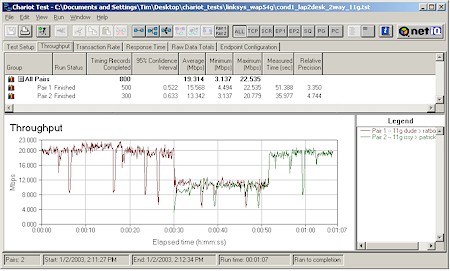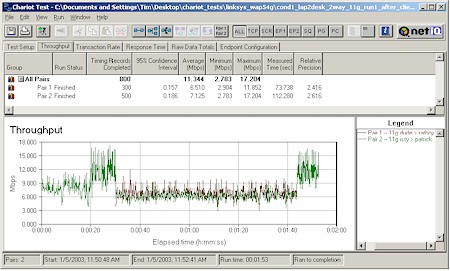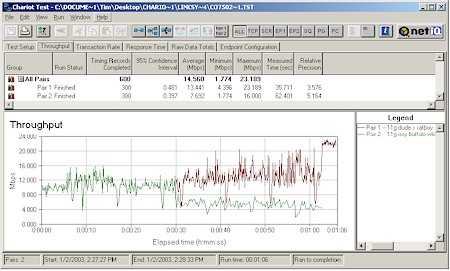802.11g Issues
I moved on to checking the WAP's ability to handle multiple draft-11g clients, hoping that at least that performance was in order. First, the good news, which is shown in Figure 11.

Figure 11: Two pair test - Two WPC54G
(click on the image for a full-sized view)
These results are consistent with how a well-behaved AP should function when hit with two equal bandwidth loads, i.e. throughput is shared equally while two clients are running and jumps back to a higher rate with one client. But if you look closely at Figure 11 and compare it with Figure 6, you'll notice that the single-client throughput in Figure 11 is about 20Mbps... significantly higher than the 14Mbps that I previously measured! Where did that come from?!
As I learned from the Linksys PM, I was seeing another effect of the current firmware - client wamup. It seems that clients running the current version firmware achieve better throughput after they've been running for 20 minutes or so. It turned out that I'd seen this effect early on in my testing, but hadn't recognized it for what it was and therefore hadn't been able to reproduce it. Now armed with the cause-and-effect info, I was easily able to reproduce my earlier results, an example of which is shown in Figure 12.

Figure 12: Two pair test - Two WPC54G - no warmup
(click on the image for a full-sized view)
The plot clearly shows about half the throughput of a warmed-up pair of clients, but at least they share bandwidth equally! As a final draft-802.11g mode check, I decided to see if the WAP54G played nice with a BuffaloTech '54g' client card. The results are shown in Figure 13.

Figure 13: Two pair test -Linksys WPC54G & BuffaloTech WLI-CB-G54
(click on the image for a full-sized view)
This plot shows the BuffaloTech client starting first, joined by the Linksys for awhile, then stopping to let the Linksys finish by itself. You can clearly see that the BuffaloTech card ends up with the short end of the throughput stick. What you can't tell is how much of what you're seeing is due to the BuffaloTech card's "throughput hopping" behavior. I hope that's the case, because otherwise the results indicate interoperability issues between products that both use Broadcom's '54g' technology.